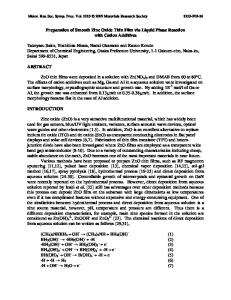Nanocrystalline tungsten oxide thin film: Preparation, microstructure, and photochromic behavior
- PDF / 396,368 Bytes
- 7 Pages / 612 x 792 pts (letter) Page_size
- 36 Downloads / 393 Views
Y.W. Cao and J.N. Yao Institute of Chemistry and Center for Molecule Science, Chinese Academy of Sciences, Beijing 100080, People’s Republic of China
E.G. Wang State Key Laboratory for Surface Physics, Institute of Physics and Center for Condensed Matter Physics, Chinese Academy of Sciences, P.O. Box 603-8, Beijing 100080, People’s Republic of China (Received 16 September 1999; accepted 3 February 2000)
A nanocrystalline tungsten oxide photochromic thin film was prepared by colloid chemistry method. The microstructure, phase transition involved in the solution process, photochromic behavior, and mechanism of the film were investigated by means of transmission electron microscope, x-ray diffraction, ultraviolet-visible absorption spectra, and x-ray photoelectron spectra. It was found that the particle size and crystallinity of the thin film could be easily controlled by adjusting the concentration of oxalic acid in the colloid solution of tungsten oxide hydrate. With the increase of the oxalic acid concentration, the size of nanoparticles in the film decreased sharply, and meanwhile, a blue shift of the absorption peaks caused by the quantum size effect was observed accordingly. With the increase of the pH in the solution, tungsten oxide hydrate was gradually transformed into an oxided 12-tungstate with Keggin structure, which led to the change of photochromic property of the films. The photochromism of the film is believed to be due to the electron transfer between the different valence states of tungsten ions located in adjacent sites.
I. INTRODUCTION
Photochromism of transition-metal oxides has been the focus of much attention because of their promising applications in information display devices, high-density memories, and photoelectric sensors.1,2 Tungsten oxide is typical of this kind of material, and the transparent WO3 films can be changed to dark blue after being exposed to ultraviolet light. Since the first report on the photochromic property of ␣–WO3 films by Deb6 in 1973, the preparation, microstructure, and photochromic process of WO3 films have been extensively studied. However, most of the early investigations were carried out on amorphous ␣–WO3 films, and the preparation of this film was mainly focused on various physical deposition methods,3,4 such as vacuum deposition and magnetron sputtering, etc. In spite of easy operation of physical deposition methods, the devices are often complicated and expensive, and it is hard to directly obtain the crystalline films by these deposition methods. Moreover, the a)
Address all correspondence to this author. e-mail: [email protected] J. Mater. Res., Vol. 15, No. 4, Apr 2000
http://journals.cambridge.org
Downloaded: 28 May 2014
density, durability, and uniformity of the films obtained by physical deposition methods are not sufficient, which makes the application of this film far from realization. The method of semiconductor colloids for design of optically transparent thin films has attracted considerable interest in recent years.5 In this method, the
Data Loading...










